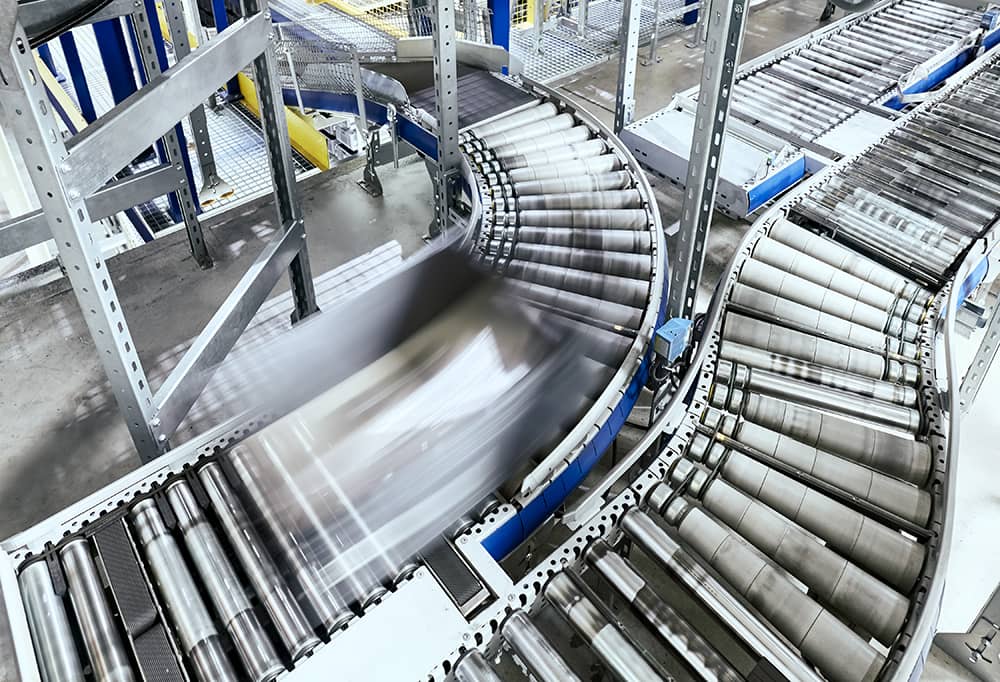

The conveyor systems industry shows no signs of slowing down in 2025, and this is undoubtedly good news for all roller conveyor manufacturers and suppliers. In fact, the conveyor system market is forecasted to grow at a CAGR of 6.4% from 2025 to 2034, with a forecasted revenue of $13.19 billion in 2034.
As ecommerce, manufacturing, food and beverage, and other industries ramp up their operations, the demand for faster and more efficient conveyor systems will only rise. The question is: How will a conveyor system keep up with the pace? The answer lies with automation.
This blog will explore how automation helps roller conveyor manufacturers design smart conveyors and its impact on the industry.
The Traditional Roller Conveyor System
Traditional roller conveyor systems feature two types of roller conveyors: Gravity Roller Conveyors and Powered Roller Conveyors.
Gravity roller conveyors make use of inclined angles and gravity to help the products move. In contrast, powered roller conveyors use motors to drive the rollers.
Automatic Roller Conveyors
At its core, automatic roller conveyors pair roller conveyors with a variety of automation technologies as per the use case to improve the efficiency of moving goods, reduce the need for manual efforts, and enhance the overall speed of handling goods.
Some of the automated technologies paired with roller conveyor systems include:
- Palletizing and depalletizing systems
- Automated sortation systems
- Internet of Things (IoT) Sensor
- Vision systems
Palletizing and Depalletizing Systems
Traditionally, you’d have to employ a group of workers to load and unload the goods onto the roller conveyors. Thanks to these automated palletizing and depalletizing systems, today, robotic arms or layer-based systems load and unload goods. This effectively reduces the labor force needs, time taken and improves throughput.
Automated Sortation Systems
When it comes to product manufacturing or packaging, there can be multiple steps in the process. Automated sortation systems employ sensors, scanners, and diverters to make this process easier. They detect and direct items to their designated chutes, bins, or next conveyor belt. This way, the entire process can be automated for speed and accuracy.
These automated conveyor systems can process thousands of items within minutes with little to no errors. Consequently, it helps you meet tight deadlines while reducing labor costs.
Internet of Things (IoT) Sensor & Machine Learning
The integration of Internet of Things (IoT) sensors in roller conveyor systems has made it possible to adjust the speed between conveyor systems, reducing energy loss. Additionally, it has improved belt mistracking issues, which are important for airports, mining, manufacturing, and transportation.
IoT-based conveyor systems are believed to offer timely warnings to prevent accidents during coal production. Furthermore, machine learning in roller conveyor systems has improved maintenance strategies by using predictive analysis to detect equipment failures and avoid production disruptions.
Vision Systems
Vision systems are essentially capable of capturing images of processes or objects and then applying algorithms to identify patterns, colors, and other features.
As part of roller conveyor systems, they automatically inspect if the product is present and free of defects. They can detect scratches, cracks, discoloration, missing parts, or damage and sort them out. Conveyor-based vision systems are also adept at accurately measuring products for consistency and product quality.
Conclusion
Automation in roller conveyor systems adds more value to a typical roller conveyor system. It allows it to do much more than just transport goods. In fact, it makes the roller conveyor system an important checkpoint for product quality and consistency. Furthermore, it enables and optimizes the entire system to complete the tasks with minimal human intervention, rendering it indispensable for industries.
Automag, a leading roller conveyor manufacturer and supplier, has best in class conveyor systems since 1985. As one of the best roller conveyor suppliers, our roller conveyor systems come in versatile configurations with multiple drive options and frame structures to meet your unique needs. Get in touch with us and see how we can transform your processes.
ALSO READ
Understanding the Functions of Roller Conveyors
How Roller Conveyors Drive the Automotive Industry
How Roller Conveyors Help Reduce Manual Labor and Improve Workplace Safety
Friction Conveyor vs Roller Conveyor: Key Differences and Applications
The Benefits of Partnering with a Reliable Roller Conveyor Supplier


